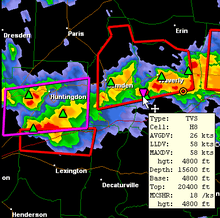GRLevelX

GRLevelX is a suite of data processing and display programs developed by Gibson Ridge Software, LLC (GRS), to view weather radar data. It went on the market in March 2005. It comes in three versions, all of which ingest raw data: GRLevel2 and GRLevel2 Analyst Edition for viewing Level II data of the National Weather Service, and GRLevel3 for viewing Level III data. Both program lines feature high speed, high quality displays with an intuitive user interface. All programs are capable of rendering dual polarization data.
The software allows the user to view real time data and analyze it on spot. It also can load archive data stored locally or over the internet. It is used by professional forecasters and researchers for general precipitation analysis as well as severe storm, tornado, and tropical cyclone monitoring and analysis. Its usage base grew to include many television weathercasters, including by The Weather Channel severe storms expert Greg Forbes, as well as storm chasers, storm spotters, emergency managers, weather enthusiasts, and is often used within the NWS, itself.
GRLevel2 Analyst Edition allows the user to take a 3D images of precipitation within clouds, such as in supercell thunderstorms. It's integrated algorithms flag possible hail, tornado vortex signatures, and mesocyclones.
All GRx applications are written in multithreaded C++ using the base Windows APIs. Software engineer Michael Scott Gibson wrote the programs.[1]
Overview

GRLevel2 is a Windows viewer for live and archived NEXRAD Level II data (volumetric reflectivity and velocity data[2]). Base reflectivity, base velocity, storm relative velocity, and spectrum width sweeps for all radar tilts can be ingested. The display has high speed zooming and panning to allow the user a quickly focus on the area of interest.
GRLevel2 Analyst Edition is an advanced NEXRAD Level II analysis application to produce a high quality volumetric display and several high resolution reflectivity-derived graphical products in addition to the standard Level II data products.
GRLevel3 is a Windows viewer for live NEXRAD Level III data from the NWS Radar Product Central Collection Dissemination Service (already produced 2D images[3]). Many television meteorologists, storm chasers, and weather enthusiasts use this software to locate supercells, tornadoes, rain, and other weather phenomenon.
Gibson also wrote GREarth, which overlays satellite and other data and, like the GRLevelX radar viewers, is customizable with GIS layers.[4]
Algorithms


GR2Analyst contains algorithms flagging certain features in the reflectivity data. In reflectivities, GR2 extract the height above ground of the highest elevation where they are greater than 18 dBZ (Echo tops), the vertically integrated liquid water content of clouds (VIL) and the VIL divided by the Echo tops which is an indicator of possible large hail. Further algorithm use environmental information about of 0C and -20°C heights, inputted by the user, to output an hail algorithm size. The algorithm uses any temp/height data within 48 hours of the volume scan time. If no recent data is found, it defaults to 10,000 ft and 20,000 ft for the heights.
The results are displayed with a high resolution of 1 km x 1° x 230 km grid with 256 data levels. There is an automatic extraction of the storm motion which is integrated in the algorithms for corrections.
System requirements
GR2Analyst has significant system requirements:
- Windows XP or above
- DirectX 9.0c or newer
- Graphics adapter with shader model 2.0 support but the 3D volume products are both CPU and GPU intensive, requiring a fast CPU and mid to high end graphics adapters
References
- ↑ About GRLevelX
- ↑ "Level II Radar". UCAR. 2009. Retrieved 2009-10-23.
- ↑ "Level III Radar". UCAR. 2009. Retrieved 2009-10-23.
- ↑ GREarth User Guide